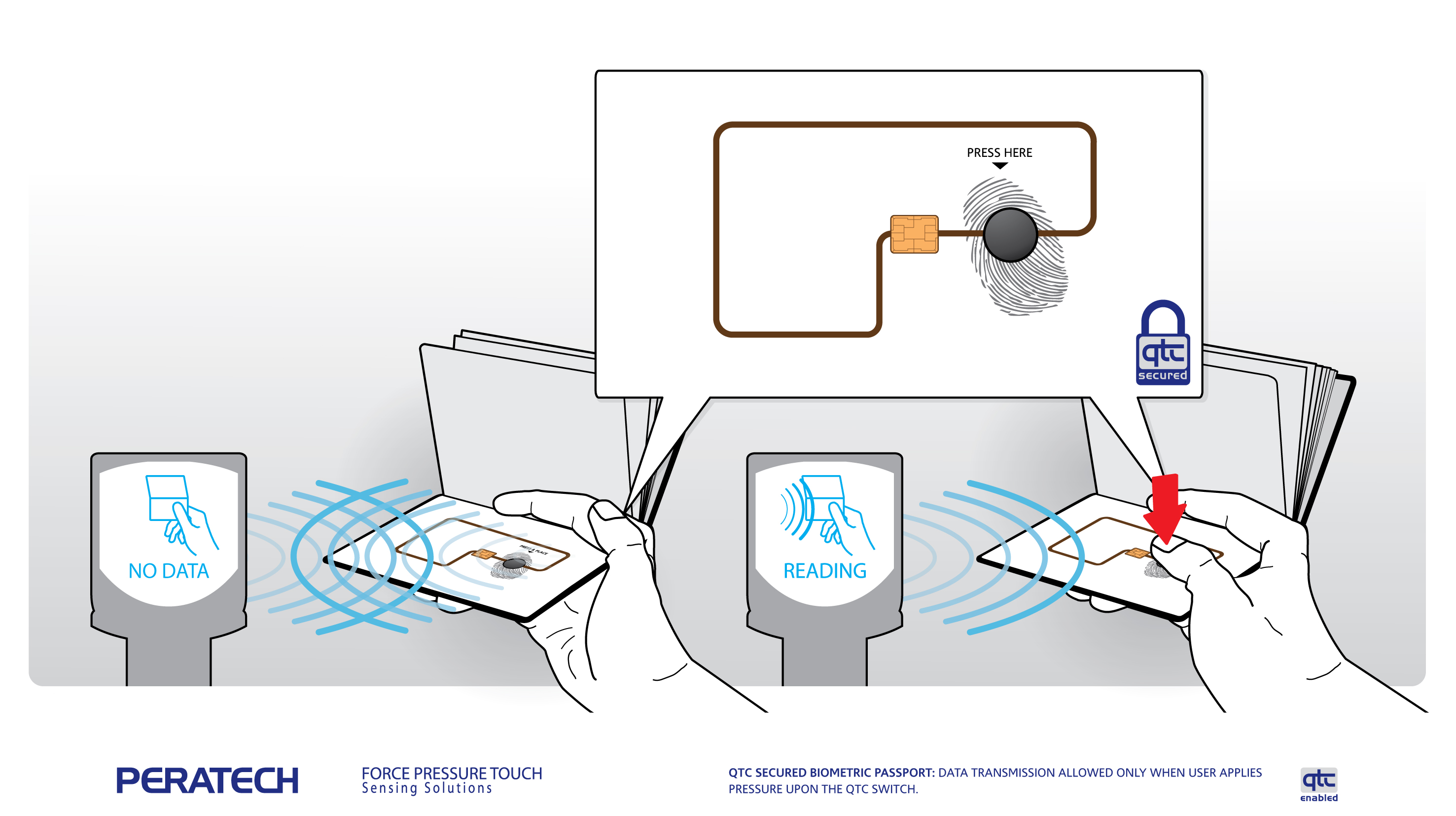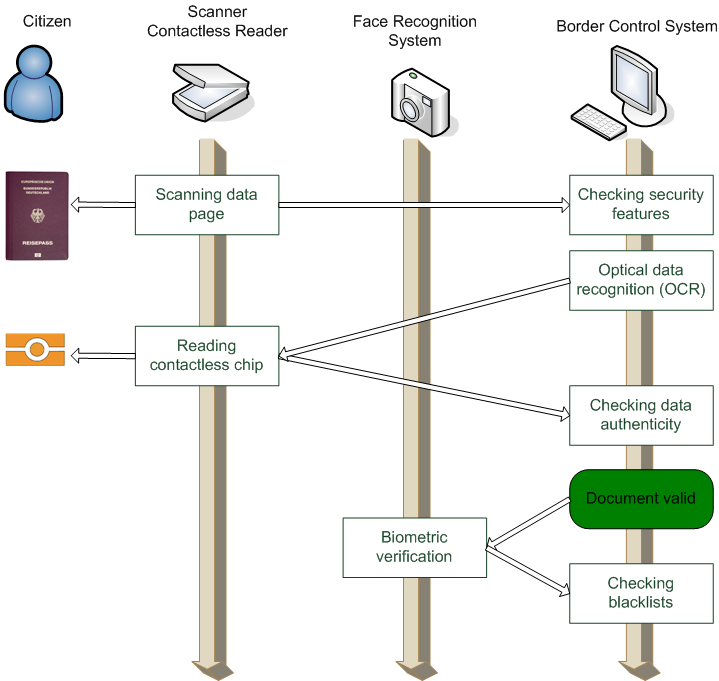Entering an era of mass surveillance, criminalization of the immigrant, and the militarization of the border, one specific design object becomes sacred: the passport. Though not technically or ubiquitously spatially intelligent, its geopolitical use assists in identification and exclusion. Its primary purpose is to “certify the identity and nationality of its bearer,” while creating a polymorphous citizenship according to levels of migratory freedom (Baxi and Cheng).

Source: InfoWatch
The evolution of the passport as a design object has consistently become more high-tech. As border crossing becomes increasingly stringent and immigration a top priority in government, the booklet is no longer exclusively symbolic and aesthetic. Secret, coded information is developed to communicate to Border Patrol, with technology and standards established by a supranational organization, the International Civil Aviation Organization (ICAO).
“This passport contains sensitive electronics. For best performance please do not bend, perforate or expose to extreme temperatures or excess moisture”.
Today, the passport booklet is designed to include a minimum use of different features that measure levels of security concerns, such as watermarks, holograms, and special markings or hidden messages. Additionally, all passports MUST be machine readable, a mandate established in 2015. This automation of “border labor” removes the human entirely and allows the communication of two technical objects, the passport and the machine, to produce the data verifying a person’s identity. The mysterious code at the bottom of the passport page incorporates various algorithms and information that is read by the machine to identify whether it is a counterfeit or not. Finally, and most surprisingly, almost all passports have chips embedded into them with specific information on the carrier’s identity. In some countries, this chip holds information of the identity’s bio page, but can also include biometrics. In essence, the review and entrance of a body becomes an exam or test, similarly to fields guides mentioned in Mattern’s “Cloud and Field.” Certain markers must be identified on the object to give permission for entrance into the border.
Source: protocolbench
The method is simple:
- A first level feature must be recognized, like a hologram or image on the passport.
- An identifiable marker not recognized by the general public, such a strip of mylar, plastic thread, or a message.
- “Covert” features that give inspectors an extra layer of confidence if they’re inspecting a possible counterfeit.
Passports with biometric chips, known as eMTRD (electronic Machine Readable Travel Documents), test three types of biometrics according to Doc 9303 from ICAO: facial recognition (MANDATORY), fingerprint recognition (OPTIONAL), and iris recognition (OPTIONAL). It creates a template in that moment with an algorithm for storage to assist in future identification, with intelligence that’s adaptable and organizational. The larger network holds the ability for mass storage, while the chip on the passport holds 32kB of storage space.

Though eMTRDs increase efficiency and accuracy at the border, there are still dangers involved with this level of technology. A passport now carries more information than it has before, which puts the holder at high risk of identity theft. Data could be stolen via “skimming” or “eavesdropping,” similarly to methods of credit card identity theft. The databases held by the State Department that hold hundreds of millions of template identities, although highly secured, still risk potential hacks. Additionally, this technology still runs the risk of glitching, especially with such a large network. Any hiccup in the system can potentially affect the entrance of a certain individual, which can be both physically dangerous and/or psychologically upsetting until the problem is dealt with. While these systems are technologically advanced in the moment, they will eventually become outdated, especially as nations compete for higher border security. It begs to question if the promotion of innovation is for efficiency and safety, or to feed the larger military industrial complex that surveils us in Foucauldian fashion.
References:
http://www.wordsinspace.net/secure/BaxiCheng_CitizenshipDesign.pdf
http://www.icao.int/publications/Documents/9303_p9_cons_en.pdf
http://www.citylab.com/tech/2017/01/the-high-tech-passport-security-technology/512855/
http://www.npr.org/templates/story/story.php?storyId=102056426


Hey Guillermo,
I appreciated your observations about the limitations and or glitches that can (and likely will) occur with the advance of automated border systems. However, I wanted to posit some further questions about how you see this (or if you see this) impacting migrants, refugees, and or stateless persons who cross borders through informal means. What I mean by this is, is that a majority of the worlds borders are unguarded or without mass security- yet the surveillance state prevails through other manifestations of securitization (things such as the use of hostile landscapes, stereotyping, and or criminalizing persons who are found to be without identification). In these instances, “the intelligence” of the “smart” passports becomes obsolete and is instead replaced by “the intelligence” of the “dumb” citizen. To play devils advocate, could a higher confidence in formal border security, due to increased automation, lead society to feel at ease that those who are here belong here? Or rather, is the surveillance state so deeply embedded in social fabric that our own anxieties of “otherness” will always prevail and such technological advances are merely performative. This is of course an incredibly complicated and contested topic and I’d love to continue the conversation further- maybe I’ll post more later.
It’s interesting to think of the biometric passport as a sort of cyborg artifact that directly imbricates human bodies in the ongoing construction and maintenance of political borders. I appreciate your inclusion of the the diagram which shows the multiple technical systems the passport interfaces with; something like this could be re-imagined as a diagram of socio-technical systems embedded within the passport. I also like that you bring up “glitching” towards the end. Though, in the example you provided, the glitch represents an existential risk, one might consider how “glitching” could be re-scripted as a subversive/political hack.
I really like your analysis in this and especially the last part about identity and all the complications that come with it. There are two links I want to share with you:
1. The UN UN platform, through which you can lend your nationality and swap passports to those in need, that I had mentioned in class: https://www.greenprophet.com/2015/11/swap-passports-design-vulpi/ and
2. How could a passport represent an individual’s multiple identities: https://www.dezeen.com/2017/03/15/dan-hill-opinion-passport-design-multiple-nested-identities-estonia-e-resident/
I think there are so many privacy and identity questions that arise in your topic and especially if the system was hacked. For some reason, I am also thinking of non-humans, service dogs for example. Would they also start needing their own passport if all this system becomes automated? What would that type of interaction look like when they travel?
I am also thinking about all the discrimination and racism refugees or immigrants go through at passport control now. Will that discrimination be embedded in our new automated systems or will they actually be more tolerant and less discriminating that we are?
Super relevant. I read an article recently about how there’s been an increase in border patrol asking US Citizens (specifically those with Muslim names) for access to their social media passwords. Citizens can be detained for hours if they refuse, eventually let go, but with the promise of a potential warrant for further investigation. As for non-citizens, failure to authorize access leads to automatic denial of entry into the country. The way things are going now- I wonder if down the line passports will have our social media accounts attached to them. Fearsome thought. An aggregate of so much of our personal information and identity in one physical object really is cause of security concern.